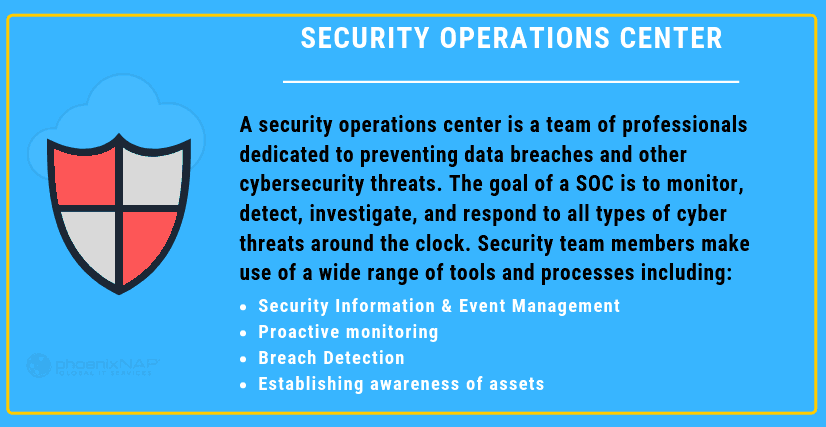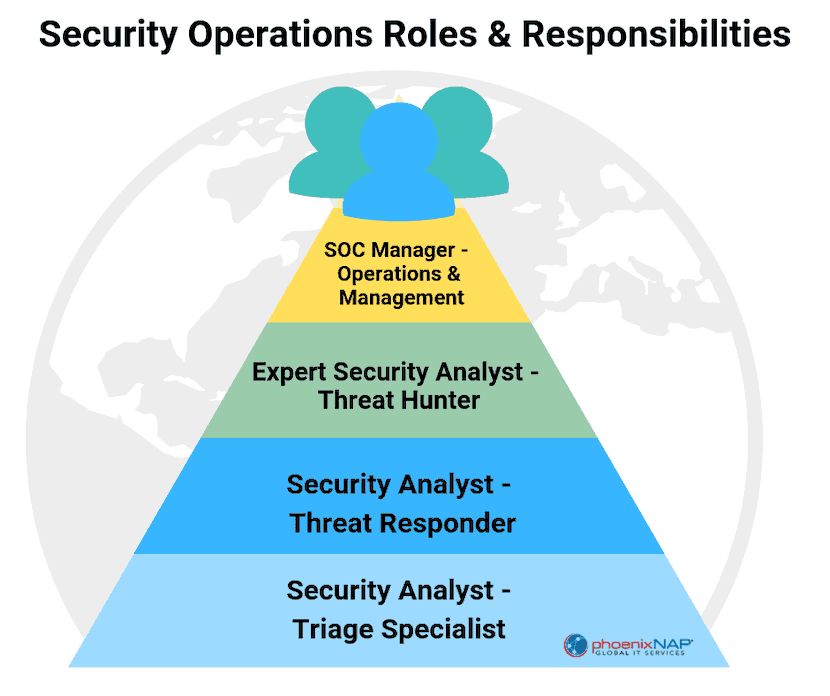In this article you will learn:
- Understand what a Security Operations Center is and active how detection and response prevent data breaches.
- Six pillars of modern security operations you can’t afford to overlook.
- The eight forward-thinking SOC best practices to keep an eye on the future of cybersecurity. Including an overview and comparison of current Framework Models.
- Discover why your organization needs to implement a security program based on advanced threat intelligence.
- In-house or outsource to a managed security provider? We can help you make a decision.
In 2018, the average cost of a breach was $3.86m. As businesses grow increasingly reliant on technology, cybersecurity is becoming a more critical concern.
Cloud security can be a challenge, particularly for small to medium-sized businesses that don’t have a dedicated security team on-staff. In this article we will take a closer at SOCs and the benefits they provide. We will also take a look at how businesses of all sizes can take advantage of SOCs for data protection.
What is a Security Operations Center?
A security operations center is a team of cybersecurity professionals dedicated to preventing data breaches and other cybersecurity threats. A SOC’s goal is to detect, investigate and respond to cyber threats at all times. SOCs have many tools to continuously scan a network for threats and weaknesses and address those threats and deficiencies before they become a serious issue. SOCs have many tools to continuously perform vulnerability scans of a network for threats and weaknesses and address those threats and deficiencies before they turn into a severe issue.
It may help to think of a SOC as an IT department that is focused solely on security as opposed to network maintenance and other IT tasks.
6 Pillars of Modern SOC Operations
Companies can choose to build a security operations center in-house or outsource to an MSSP or managed security service providers that offer SOC services. For small to medium-sized businesses that lack resources to develop their own detection and response team, outsourcing to a SOC service provider is often the most cost-effective option.

Through the six pillars of security operations, you can develop a comprehensive approach to cybersecurity.
Establishing Asset AwarenessThe first objective is asset discovery. The tools, technologies, hardware, and software that make up these assets may differ from company to company, and it is vital for the team to develop a thorough awareness of the assets that they have available for identifying and preventing security issues.
Preventive Security MonitoringWhen it comes to cybersecurity, prevention is always going to be more effective than reaction. SOCs monitor networks around the clock, rather than reacting to threats when they occur. By doing so, they can detect malicious activities and prevent them before they can cause any severe damage.
- Keeping Records of Activity and CommunicationsIn the event of a security incident, soc analysts need to be able to retrace activity and communications on a network to find out what went wrong. To do this, the team is tasked detailed log management of all the activity and communications that take place on a network.
- Ranking Security AlertsWhen security incidents do occur, the incident response team works to triage the severity. This enables a SOC to prioritize their focus on preventing and responding to security alerts that are especially serious or dangerous to the business.
- Modifying DefensesEffective cybersecurity is a process of continuous improvement. To keep up with the ever-changing landscape of cyber threats, a security operations center works to continually adapt and modify a network’s defenses on an ongoing, as-needed basis.

- Maintaining ComplianceIn 2019, there are more compliance regulations and mandatory protective measures regarding cybersecurity than ever before. A security operations center must also protect the company from legal problems. This is done by ensuring that they are always compliant with the latest security regulations.
- Security Operations Center Best Practices
- As you go about building a SOC for your organization, it is essential to keep an eye on what the future of cybersecurity holds in store. Doing so allows you to develop practices that will secure the future.
SOC Best Practices Include:
Widening the Focus of Information Security
Cloud computing has given rise to a wide range of new cloud-based processes. This has led to a dramatic expansion of the virtual infrastructure in most organizations. During the same period, other technological advances such as internet of things became more common. The cloud is now more accessible to organizations than ever. It also means they are more vulnerable to threats. As you go about building a SOC, it is crucial to widen the scope of cybersecurity to continually secure new processes and technologies as they come into use.
Expanding Data Intake
When it comes to cybersecurity, collecting data can often prove incredibly valuable. Data on security incidents can help a security operation center put incidents in the right context. They can also identify the root cause of the problem. Moving forward, an increased focus on collecting more data and organizing it in a meaningful way will be critical for SOCs.
Improved Data Analysis
Collecting more data is only valuable if you can thoroughly analyze it and draw conclusions from it. A more thorough and comprehensive analysis of your data is an important SOC best practice. Focusing on better data security analysis will empower your SOC team to make more informed decisions regarding the security of your network.
Take Advantage of Security Automation
Cybersecurity is becoming increasingly automated. DevSecOps practices can be used to automate more time-consuming and tedious security tasks, allowing your team to spend their energy and time on more important tasks. As cybersecurity automation continues to advance, organizations need to focus on building SOCs that are designed to take advantage of the benefits that automation offers.
Security Operations Center Roles and Responsibilities
A security operations center is made up of a number of individual team members. Each member of the team has a unique set of duties. Team members may differ. The manager is in charge of the security team. They are responsible for managing the team, setting budgets and agendas, and reporting to executive managers within the organization.
Security Analyst
A security analyst is responsible for organizing and interpreting security data from SOC report or audit. Also, providing real-time risk management, vulnerability assessment, and security intelligence provide insights into the state of the organization’s preparedness.
- Forensic InvestigatorIn the event of an incident, the forensic investigator is responsible for analyzing the incident to collect data, evidence, and behavior analytics.
- Incident ResponderIncident responders are the first to be notified when security alerts happen. They are then responsible for performing an initial evaluation and threat assessment of the alert.
- Compliance AuditorThe compliance auditor is responsible for ensuring that all processes carried out by the team are done so in a way that complies with regulatory standards.
- SOC Organizational ModelsNot all SOCs are structured under the same organizational model.
- Security operations center processes and procedures vary based on many factors, including your unique security needs.

Organizational models of security operations centers include:
Internal SOCAn internal SOC is an in-house team comprised of security and IT professionals who work within the organization. The internal team can be distributed across departments. They can also comprise their own department dedicated to security.Internal Virtual SOC
An internal virtual SOC is comprised of part-time security professionals who work remotely. Team members are primarily responsible for reacting to security threats when they receive an alert.
- Co-Managed SOC
A co-managed SOC is a team of security professionals who work alongside a third-party cybersecurity service provider. This organizational model essentially combines a semi-dedicated in-house team with a third-party SOC service provider for a co-managed approach to cybersecurity. - Command SOC
Command SOCs are responsible for overseeing and coordinating other SOCs within the organization. A fusion SOC oversees the IT team of an organization. Their objective is to guide and assist the IT team on matters of security. - Outsourced Virtual SOC
An outsourced virtual SOC is made up of team members that work remotely. Outsourced virtual SOCs are not directly employed by the organization. Instead, they work as a third party service. Outsourced virtual SOCs provide security services to organizations that do not have an in-house security operations center team on-staff. - Take Advantage of the Benefits Offered by a SOC
Faced with ever-changing security threats, the security offered by a security operations center is one of the most beneficial avenues that organizations have available. A team of information security professionals can help you keep your data safe by monitoring your network and detecting security threats.
